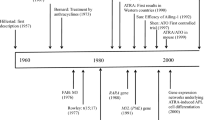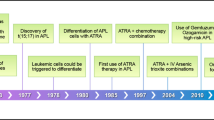Opinion statement
The treatment of acute promyelocytic leukemia (APL) is different from other subtypes of acute myelocytic leukemia (AML). All trans-retinoic acid (ATRA) is an essential component of the standard remission induction for all newly diagnosed APL patients. Remission induction with ATRA and chemotherapy given concurrently appears to be associated with fewer relapses. With further consolidation chemotherapy without high-dose cytosine arabinoside, the disease-free survival rate can reach 70% to 80%, and many of these patients are cured, more so than in any other AML subtype. APL is especially sensitive to anthracyclines, which should be included in the chemotherapy cycles at a higher dose than in other AML subtypes. Maintenance with low-dose chemotherapy (oral daily 6-mercaptopurine with weekly methotrexate) or ATRA further improves the long-term outcome. New approaches are also available for relapsing patients, although the optimal treatment is unknown. Patients who did not receive oral ATRA in first relapse can be treated with this agent, as can first relapsing patients who have been off the drug for more than 1 year. Because of poor remission rates, ATRA should not be used in patients with second or subsequent relapses (whether ATRA was given in the past), in patients with relapses early after ATRA discontinuation, or in patients relapsing while on ATRA therapy. Arsenic trioxide can also be used, especially in patients resistant to ATRA. Because arsenic trioxide is still experimental and not yet widely available, patients who are unlikely to respond to ATRA or who unsuccessfully undergo ATRA reinduction should be treated with chemotherapy. Patients in second or subsequent remission induced with ATRA or chemotherapy should receive consolidation chemotherapy. When arsenic trioxide is used for reinduction, the drug should be continued for several cycles; however, adding consolidation chemotherapy might improve the results. Because it is unknown whether APL in second or subsequent remission is curable with salvage therapy, allogeneic hematopoietic stem cell transplantation is often considered for patients with a human leukocyte antigen (HL-A)-identical sibling and autologous transplantation when a donor does not exist. However, compared with the new treatments, the role of transplantation for relapse is unclear. In first remission, there is no role for transplantation. A new liposomal formulation of intravenous ATRA is being investigated and seems effective in late first relapses, and it may be able to induce and maintain first remissions in selected patients without chemotherapy.
Similar content being viewed by others
References and Recommended Reading
Melnick A, Licht JD: Deconstructing a disease: RARalpha, its fusion partners, and their roles in the pathogenesis of acute promyelocytic leukemia. Blood 1999, 93:3167–3215. An excellent review on the pathogenesis of acute promyelocytic leukemia for more in-depth reading.
Grimwade D: The pathogenesis of acute promyelocytic leukemia: evaluation of the role of molecular diagnosis and monitoring in malignancy of the disease. Br J Haematol 1999, 106:591–613.
Stone RM, Mayer RJ: The unique aspects of acute promyelocytic leukemia. J Clin Oncol 1990, 8:1913–1921.
Avvisati G, Mandelli F, Petti MC, et al.: Idarubicin (4-demethoxydaunorubicin) as single agent for remission induction of previously untreated acute promyelocytic leukemia: a pilot study of the Italian cooperative group GIMEMA. Eur J Hematol 1990, 44:257–260.
Head D, Kopecky KJ, Weick J, et al.: Effect of aggressive daunomycin therapy on survival in acute promyelocytic leukemia. Southwest Oncology Group. Blood 1995, 86:1717–1728.
Degos L, Dombret H, Chomienne H, et al.: Alltrans-retinoic acid as a differentiating agent in the treatment of acute promyelocytic leukemia. Blood 1995, 85:2643–2653.
Tallman MS, Andersen JW, Schiffer CA, et al.: Alltrans-retinoic acid in acute promyelocytic leukemia. N Engl J Med 1997, 337:1021–1026. This article gives the results of the randomized U.S. intergroup trial that established the role of ARTA in APL.
Asou N, Adachi K, Tamura J, et al.: Analysis of prognostic factors in newly diagnosed acute promyelocytic leukemia treated with all-trans retinoic acid and chemotherapy. J Clin Oncol 1998, 16:78–85.
Fenaux P, Le Deley MC, Castaigne S, et al.: Effect of all trans retinoic acid in newly diagnosed acute promyelocytic leukemia. Results of a multicenter randomized trial. European APL 91 Group Blood 1993, 82:3241–3249.
Avvisati G, Lo Coco F, Diverio D, et al.: AIDA (all-trans retinoic acid + idarubicin) in newly diagnosed acute promyelocytic leukemia. Blood 1996, 88:1390–1398.
Fenaux P, Wattel E, Archimbaud E, et al.: Prolonged follow-up confirms that all-trans retinoic acid followed by chemotherapy reduces the risk of relapse in newly diagnosed acute promyelocytic leukemia (letter). The French APL Group. Blood 1994, 84:666–667.
Fenaux P, Chastang C, Chevret S, et al.: A randomized comparison of all transretinoic acid (ATRA) followed by chemotherapy and ATRA plus chemotherapy and the role of maintenance therapy in newly diagnosed acute promyelocytic Leukemia. Blood 1999, 94:1192–1200. Another very large randomized trial discussing the role of ATRA in induction and maintenance.
Burnett AK, Goldtsone AH, Gray RG, Wheatley K: All trans retinoic acid given concurrently with induction chemotherapy improves outcome in APL: results of the UK MRC ATRA trial (abstract). Blood 1997, 90(suppl 1):330a.
Estey E, Thall PF, Pierce S, et al.: Treatment of newly diagnosed acute promyelocytic leukemia without cytarabine. J Clin Oncol 1997, 15:483–490.
Chen A, Xue YQ, Zhang R, et al.: A clinical and experimental study on all-trans retinoic acid-treated acute promyelocytic leukemia patients. Blood 1991, 78:1413–1419.
Chao N, Hua Y, Ting Y, et al.: Studies on treatment of acute promyelocytic leukemia with arsenic arioxide: remission induction, follow-up, and molecular monitoring in 11 newly diagnosed and 47 relapsed acute promyelocytic leukemia patients. Blood 1999, 94:3315–3324. A new study describing the effect of arsenic trioxide in newly diagnosed and relapsed APL patients.
Soignet S, Frankel S, Tallman M, et al.: U.S. multicenter trial of arsenic trioxide (at) in acute promyelocytic leukemia (APL) (abstract). Blood 1999, 94 (suppl 1):968a.
Meloni G, Diverio D, Marco Vignetti, et al.: Autologous bone marrow transplantation for acute promyelocytic leukemia in second remission: prognostic relevance of pretransplant minimal residual disease assessment by reverse-transcription polymerase chain reaction of the PML/RAR fusion gene. Blood 1997, 90:1321–1325.
Diverio D, Rossi V, Avvisati G, et al.: Early detection of relapse by prospective reverse transcriptase-polymerase chain reaction analysis of the PML/RARalpha fusion gene in patients with acute promyelocytic leukemia enrolled in the GIMEMA-AIEOP multicenter “AIDA” trial. GIMEMA-AIEOP Multicenter “AIDA” Trial. Blood 1998, 92:784–789.
Lo Coco F, Diverio D, Avvisati G, et al.: Therapy of molecular relapse in acute promyelocytic leukemia. Blood 1999, 94:2225–2229. A good resource on molecular remission and relapse in APL.
Estey EH, Giles FJ, Kantarjian H, et al.: Molecular remissions induced by liposomal-encapsulated all-trans retinoic acid in newly diagnosed acute promyelocytic leukemia. Blood 1999, 94:2230–2235. Use of intravenous liposomal ATRA and the ability to obtain long-term molecular remission without chemotherapy.
Mandelli F, Labopin M, Granena A, et al.: European survey of bone marrow transplantation in acute promyelocytic leukemia (M3). Working Party on Acute Leukemia of the European Cooperative Group for Bone Marrow Transplantation (EMBT). Bone Marrow Transplant 1994, 14:293–298.
Tallman MS, Andersen JW, Schiffer CA, et al.: Clinical description of 44 patients with acute promyelocytic leukemia who developed the retinoic acid syndrome. Blood 2000, 95:90–95.
De Botton S, Dombret H, Sanz M, et al.: Incidence, clinical features, and outcome of all trans-retinoic acid syndrome in 413 cases of newly diagnosed. Blood 1998, 92:2712–2718.
Muindi J, Frankel SR, Miller WH Jr, et al.: Continuous treatment with all-trans retinoic acid causes a progressive reduction in plasma drug concentrations: implications for relapse and retinoid “dresistance” in patients with acute promyelocytic leukemia. Blood 1992, 79:299–306.
Muindi JRF, Frankel SR, Huselton C, et al.: Clinical pharmacology of oral all-trans retinoic acid in patients with acute promyelocytic leukemia. Cancer Res 1992, 52:2138–2146.
Delva L, Cornic M, Balitrand N, et al.: Resistance to all-trans retinoic acid (ATRA) therapy in relapsing acute promyelocytic leukemia: study of in vitro ATRA sensitivity and cellular retinoic acid binding protein levels in leukemic cells. Blood 1993, 82:2175–2181.
Camacho LH, Soignet SL, Heller G, et al.: Leukocytosis and the “retinoic acid syndrome” during induction treatment of acute promyelocytic leukemia with arsenic trioxide (abstract). Blood 1999, 94(suppl1):595a.
Giannì M, Koken MHM, Chelbi-Alix MK, et al.: Combined arsenic and retinoic acid treatment enhances differentiation and apoptosis in arsenic-resistant NB4 cells. Blood 1998, 91:4300–4310.
Mehta K, Sandeghi T, McQueen T, Lopez-Bernstein G: Liposome encapsulation circumvents the hepatic clearance mechanisms of all-trans-retinoic acid. Leukemia Res 1994, 18:587–596.
Estey E, Thall PF, Mehta K, Rosenblum M, et al.: Alterations in tretinoin pharmacokinetics following administration of liposomal all-trans retinoic acid. Blood 1996, 87:3650–3659.
Drach J, Lopez-Berestein G, McQueen T, et al.: Induction of differentiation in myeloid leukemia cell lines and acute promyelocytic leukemia cells by liposomal all-trans-retinoic acid. Cancer Res 1993, 53:2100–2119.
Estey E, Douer D, Wiernick P, et al.: Treatment of recurrent acute promyelocytic leukemia with liposomal all trans retinoic acid (dabstract). Blood 1997, suppl 1:332a.
Tobita T, Takeshita A, Kitamura K, et al.: Treatment with a new synthetic Retinoid, Am80, of acute promyelocytic leukemia relapsed from complete remission induced by all-trans retinoic acid. Blood 1997, 90:967–973.
Author information
Authors and Affiliations
Rights and permissions
About this article
Cite this article
Douer, D. Acute promyelocytic leukemia. Curr. Treat. Options in Oncol. 1, 31–40 (2000). https://doi.org/10.1007/s11864-000-0013-1
Issue Date:
DOI: https://doi.org/10.1007/s11864-000-0013-1




